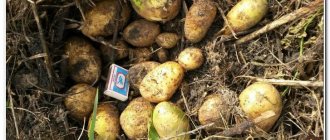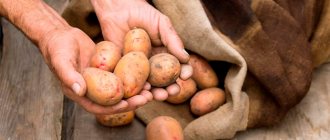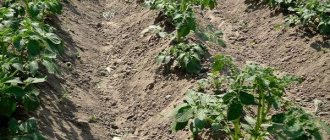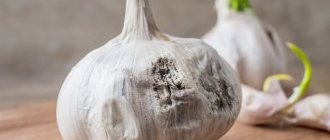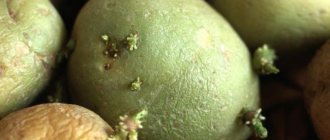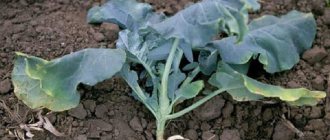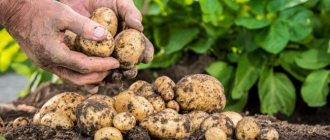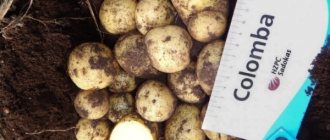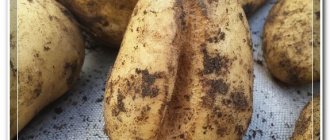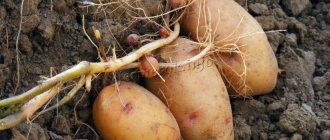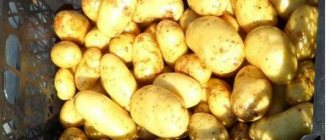Late blight
A very dangerous fungal disease that can destroy about 60-70% of the entire crop.
It is not difficult to calculate: blurry gray, sometimes brown, hard spots appear on the tubers, going deep - if you cut a potato, they can be seen on the pulp.
The disease can develop during the growing season, as well as during harvesting: a fungal infection from the tops moves to the tubers and gradually destroys them. The development of the disease continues at the very beginning of storage at a sufficiently high air temperature in the cellar.
Fungal infection is not transmitted from tuber to tuber during storage.
How to deal with late blight?
- Dig up potatoes in dry, sunny weather. Before storing, dry the tubers for several weeks in a dry, dark room with good ventilation. Then carefully sort through the potatoes - if there are suspicious spots or rotten areas on the tubers, do not put the root vegetables in the cellar.
- The air temperature in the potato storage room should be about 2-3°C, humidity 80-91%; important factors are the absence of light and good ventilation.
- Pour the potatoes into piles or boxes in a layer of no more than 1 m. Storing tubers in bags is not advisable.
- During the winter period, do not pick through the potatoes - this can lead to damage to the tubers and their further infection.
Phytophthora actively develops at high temperatures of about 20-24°C. Therefore, it is not recommended to store the crop in a residential area - the disease will destroy it very quickly.
Prevention of rotting
There are no special treatments for potato rot. The most important thing is to detect the disease in time and prevent it from spreading throughout the entire field. It is necessary to cultivate the soil and fight insects, which are a mechanism for the spread of infection.
Basic preventive measures to prevent the occurrence of rot:
- Using special fertilizers for the soil;
- High-quality selection of planting material;
- Using the crop rotation method;
- The area is cleared of weeds;
- Select potato varieties that are resistant to rot;
- Avoid planting in heavy, waterlogged soil;
- Treatment of tubers before planting with special means;
- Timely harvesting;
- Maintaining cleanliness, required temperature and humidity in the storage;
- Before harvesting, the potato tops are mowed down 2 weeks;
- If the tubers are cut before planting, this must be done 2-3 days in advance so that the cuts are closed;
- If during the growth of potatoes rot is detected on any tops, this bush must be dug up and destroyed;
- Avoid overdose of nitrogenous preparations in the soil.
An important point is the choice of potato variety for planting. It is recommended to give preference to varieties that are common in this region and have medium and late ripening.
Preparing the storage
It is very important to prepare the storage before the harvest begins. The room must be treated for rodents, dried, cleaned and, if possible, disinfected with a 5% solution of copper sulfate.
Storing potatoes in boxes
Throughout the entire storage process, the temperature and humidity conditions recommended for harvested potato varieties must be observed. Typically, the air temperature is maintained at 2-4 degrees and humidity 80-91% .
If the humidity in the storage is higher than recommended, it is permissible to install containers with quicklime, which should be updated as necessary.
Preparing the crop before storage
In order to preserve the harvest as much as possible, you must adhere to several rules.
It is important to harvest potatoes after the soil dries out, so harvesting is carried out only in dry, sunny weather. If this is not possible, the crop is slightly dried and the top dirt is carefully removed without damaging the skin.
When harvesting, only whole, healthy tubers are selected for long-term storage.
Harvesting must be done very carefully, using special means, which will reduce the risk of mechanical damage to the tubers.
Immediately after harvesting, the entire crop must be carefully inspected, and infected fruits must be destroyed. It is recommended to sort potatoes during the harvesting process, placing those affected by rot in a separate area. Mechanically damaged tubers are also deposited.
Compliance with storage conditions
Before placing the crop in storage, you can treat the tubers with a solution of the drug "Max KS" , according to the instructions on the package. As additional protection during storage, you can use fern leaves or rowan leaves, delimiting the potato layers with them.
Industrial potato harvest
After harvest, potatoes suitable for storage are moved under a shed or into a dark, ventilated room, where they are stored for a week. After the outer skin has hardened, the tubers can be moved to storage. If the bulk method is used when storing the crop, it is recommended to cover the crop with two layers of beets. It absorbs excess moisture, protecting the potatoes from rotting.
Attention! It is worth remembering that each potato variety is harvested and stored separately from each other.
Once a month it is necessary to sort out the crop. Spoiled tubers are immediately disposed of by burning.
Fusarium dry rot
First, dull depressed spots of gray-brown color appear on the tubers. After some time, the skin at the site of the spots wrinkles, the flesh becomes dry, and voids with mycelium often form in the affected parts of the tuber.
The infection penetrates along with lumps of wet soil - which is why it is recommended to harvest the crop in dry weather.
How to deal with Fusarium dry rot?
- Do not store potatoes with mechanical damage, such as cracks or cuts, or tubers with signs of late blight or scab infection - such root crops are very vulnerable to dry rot.
- Before planting, treat the tubers with the microbiological preparation Fitosporin-M (by spraying or dipping), follow the dosage indicated on the package. After this, dry them thoroughly in a dry room with good ventilation and send them to the cellar with a temperature of 2-3 ° C and a humidity of 80-91%.
- There is no need to sort through the potatoes during the entire storage period - you can accidentally damage the tubers. But if you notice affected potatoes, be sure to remove them from the cellar.
Is it possible to eat potatoes affected by rot?
Potatoes infected with rot are definitely not suitable for eating. There is an opinion that if the affected tuber is cut off from rot, it can be eaten. But is it worth exposing your body to such risks? This product is full of toxins from fungal and bacterial spores.
In another case, potatoes are used for food, which cannot be stored for a long time. It may be infected, but there are no signs of rot yet. For example, if late blight has affected only the leaves, you can safely prepare your favorite potato dishes. Also, scabbed tubers are consumed without restrictions, cutting off a thick layer of peel.
Rhizoctoniosis, or black scab
Rhizoctoniosis (black scab) is a fungal disease. A distinctive feature is flat black sclerotia that can be easily scraped off.
We have two news about this disease: good and bad.
Let's start with the good thing: black scab does not spread in the cellar during storage, is not transmitted from diseased tubers to healthy ones, and does not spoil the taste of potatoes. Bad: it can greatly harm next year’s plantings (for example, if you use seed potatoes affected by scab).
Remember: the development of the disease is facilitated by late cleaning, when it is already very cold and damp outside.
How to deal with rhizoctoniosis?
- Sort through the potato crop and discard affected tubers.
- Treat the surviving tubers with Maxim Dachnik at the rate of 2 ml per 100 ml of water (10 kg of tubers can be treated with this amount of solution), dry and store.
- The ideal air temperature in the cellar is 2-3°C, and humidity is 80-91%.
Potato varieties resistant to rot
A simple and reliable way to protect crops from diseases and pests is to grow varieties that are resistant to rot. Choose a potato variety that will not only protect against infection, but will also delight you with its taste.
Potato varieties resistant to diseases:
| Name | Disease resistance | Ripening time |
| Dewdrop | late blight, alternaria, cancer, black leg, wet rot. Potato nematode | mid-season, high-yielding |
| Peter's mystery | late blight of tops and tubers, potato cancer, relatively resistant to common scab and viral diseases | mid-season, low starch content |
| Naiad | potato cancer, moderately susceptible on tops and moderately resistant to late blight on tubers. Moderately resistant to viruses and scab | mid-late |
| Lasunok | late blight of tubers, cancer and viruses (S, M, U, L). Tolerant to rhizoctonia, blackleg, common scab, late blight of leaves | mid-late |
| Nevsky | fusarium, ring rot | late |
| Blue | Y-virus, Alternaria blight, scab, rhizoctonia, potato cancer (pathotype 1), ring and wet rot, susceptible to golden potato nematode, moderate susceptibility to late blight of tops and tubers | mid-late, high-yielding |
A careful study of the characteristics of different varieties will help you choose the right potato variety. Following simple rules is an opportunity to avoid losses and get an excellent harvest.
Wet bacterial rot
The source of the disease is putrefactive bacteria that can turn beautiful tubers into gray porridge in a few months.
First, the affected areas of the tubers darken, become covered with brown mucus, and become very soft. Such potatoes have a sad end - they rot, emitting an unpleasant odor.
Related article: Growing potatoes in bags - description of technology and video
The disease actively develops when storage conditions are violated (high temperature, humidity and poor ventilation) and when damaged potatoes are stored for storage. It is through cracks and microtraumas that bacteria penetrate the tuber, slowly destroying it.
How to deal with wet bacterial rot?
- Before storing, be sure to sort out the potatoes: discard damaged tubers. Tubers that are prepared for storage are treated with the drug Kagatnik (25-40 ml per 1 liter of water). The resulting solution is sprayed on 100 kg of potatoes.
- Follow the potato storage regime: the temperature in the cellar should be about 2-3°C (if the tubers freeze, they will be vulnerable to disease) and the humidity is about 80-91% (to reduce the humidity in the cellar, you can scatter ash on the floor, which absorbs moisture well) .
- If you notice signs of bacterial rot and even identify the “sick” one, you need to continue to periodically review your potato bins, promptly removing diseased tubers that are dangerous to healthy ones. Otherwise, the entire harvest will be at risk - and instead of fluffy puree, you will get a gray, rotting mush. Not the most pleasant prospect, right?
What to do if potatoes rot in the ground and why this happens
Potato diseases, especially various types of rot, are the scourge of many gardeners. It is very difficult to recognize the development of the disease in the early stages, and sowing into contaminated soil is fraught with damage to the tubers. How to treat potatoes against mold, why does it rot in the ground and what needs to be done if it is infected? Read on for answers to these and other questions.
Types of potato rot
Mold on potatoes is a rot caused by fungal and bacterial infections . The fight against them is difficult due to the abundant damage to the soil and the complexity of its cultivation. Also, the development of rot is facilitated by violations of the rules of crop rotation and agricultural technology - watering and fertilizing regimes.
Rubber
Rubber rot appeared in Russia relatively recently compared to other species. It affects seed germination and plant productivity, as well as the safety of tubers . The disease is of fungal origin and has two forms - tuberous and sprout.
The pathogen enters the tubers through eyes, lenticels and mechanical damage received during sowing, processing or caused by insect pests.
The tubers are covered with irregular brown spots with a black border around the entire perimeter. To the touch, the spots are dense, elastic, similar to rubber. On a cut, the affected tissue first turns pink, after which it turns brown and black. When pressed, the cut tubers release brown contents with a fishy odor.
Rubber rot develops at high soil moisture and in acidic soil at temperatures above +20°C . The source of infection is infected seed tubers, soil residues and fungal spores in the soil.
Control measures:
- compliance with crop rotation;
- improvement of planting material;
- carrying out deep plowing of the soil;
- loosening during heavy rains;
- compliance with the storage regime for seed material.
Important! There are no varieties resistant to rubber rot.
The main reasons for potato rotting in the ground
Why do potatoes rot from the inside? The main reasons include :
- violations in agricultural technology - excessive watering, lack or, conversely, excessive loosening, irregular weeding;
- non-compliance with crop rotation rules - this applies to rot with fungal etiology;
- use of diseased seed.
What is the source of infection?
The source of infection of fungal rots are affected tubers and spores remaining in the soil, while rots of bacterial origin are infected tubers. In both cases, an additional source may be diseased tops left in the soil or used as compost.
Bush affected by ring rot
How to deal with potato rot
It is almost impossible to fight rot on diseased plants . All control measures are limited to removing the diseased bush and preventing disease in those adjacent to it at a distance of at least 1 m.
Common scab
There are several types of common scab that have distinctive features:
- flat – brown “abrasions” form on the affected peel;
- mesh - the tuber is covered with small cracks resembling a mesh;
- convex - the tuber is covered with wart-like growths;
- deep - shallow depressed brown ulcers appear on the tuber, which are surrounded by torn skin.
Scab does not affect the taste, but nevertheless spoils the appearance of the potato. It is especially dangerous because it makes tubers vulnerable to putrefactive bacteria and fungi.
These sores spoil the eyes, making the potatoes completely unsuitable for planting next year.
How to deal with common scab?
- Store only healthy, undamaged tubers.
- After harvesting, let the potatoes sit in a dark, dry place with good ventilation for two weeks and only then send the tubers to the cellar.
- Remember the optimal temperature (2-3°C) and humidity (80-91%) in the room.
How to save after rains
Before resuscitation begins, the degree of danger is assessed. Analyze the condition of the earth. If the soil is slightly damp, there is no need to panic. But if the soil in your hands resembles mud, then they immediately begin to actively act.
On a note!
Frequent precipitation affects the quality of potatoes. Root crops become watery, and the shelf life of the crop decreases several times.
To protect the plantings and revive the potatoes, perform the following measures:
- Mulching the soil with the addition of fertilizers. The complexity of the procedure is that it is performed near each bush.
- Ditches for draining excess moisture. They are performed between rows.
- To speed up the process of water evaporation, you should loosen the soil as often as possible.
You should not expect that the harvest will be saved completely, but it is possible to partially save the root crops.
Spotting
Iron spot (tuber rust) is a non-infectious disease, the main symptom of which is brown spots of different sizes and shapes in the pulp. Externally, a diseased tuber is no different from a healthy one.
The cause of rusty tubers is unfavorable soil and weather conditions. The disease develops in the field, and not during storage.
Gray spot can affect tubers that have been subjected to shock during harvesting or transportation. There are no signs of the disease outside, but inside, gray spots of different sizes appear on the potato tissues.
If you boil the potatoes, the gray spots will change color - they will turn black.
How to deal with spotting?
- During harvesting, transportation and storage, be as careful as possible; do not throw potatoes away - mechanical damage can cause not only spotting, but also fungal and bacterial infections that will destroy a significant part of the crop.
- Observe the conditions recommended for storing potatoes in the cellar: temperature (2-3°C) and humidity (80-91%).
Before storing potatoes, prepare the cellar in advance: dry it, clean it, seal up rodent holes, disinfect the walls and ceiling by whitewashing them with lime. It is very good if the bins for storing crops are equipped with a lattice floor and walls.
Products that have already been stored - potatoes, carrots, onions and beets - can be processed using a bulk Vist checker. Its active ingredient is safe for both humans and vegetables. Smoking for just one minute will protect tubers and root crops from fusarium, fomoz and various types of rot for a period of up to 8 months.
Potatoes are a very attractive crop for fungi, bacteria, and insect pests. They begin to attack him while still in the field. But even after harvesting, be on alert, so that even during storage you can repel the “enemy forces” that have encroached on your harvest.
Alternaria blight (potato dry spot)
In terms of the level of damage to potato yields, this disease is similar to late blight. It affects all parts of the plant (stems, leaves, tubers). Most often, dry spotting affects mid and late potato varieties, that is, those recommended for winter storage.
Alternaria blight (dry spotting of potatoes).
During the growing season, the lesion appears on leaves and stems in the form of large concentric spots. The spots gradually become brown or dark brown with a brown tint. Depressed spots appear on the surface of the tubers, which gradually wrinkle. On a section of the tuber, the affected areas are necrotic and differ from healthy tissue by hard, dense black-brown pulp.
Reasons why potatoes rot
Harvesting vegetables in rainy or damp weather, inattention when inspecting the crop, digging too early or too late are the main causes of potato rot.
Important! To prevent rotting, the room is periodically ventilated.
In the cellar, vegetables quickly rot at high humidity, inappropriate temperature, poor ventilation, and storage in bags with low air permeability.
Rotting is caused by some dangerous diseases: late blight, bacterial rot, black scab.
Late blight
The fungal disease appears as dark spots on the tubers. When cut, you can see that the black rot goes inside the potato. Late blight occurs during the growing season, and is activated already in the cellar if the temperature exceeds the norm.
Basic control measures:
- potatoes are sorted, infected tubers are removed;
- normalize the temperature in the room;
- healthy vegetables are treated with biological products (for example, “Gamair”).
Potatoes are dug up only in sunny, dry weather and poured into boxes in a layer of about 1 m.
Wet bacterial rot
Tubers with this disease become covered within a couple of days with patches of gray mucus with a terrible smell. Temperatures above +20°C and humidity above 90% provoke the development of the disease.
To get rid of rot, do the following:
- the crop is sorted and rotten tubers are thrown away;
- normalize humidity and temperature in the cellar;
- diseased areas on vegetables are cut off, the cut area is treated with alcohol;
- The potatoes are inspected periodically.
Related article: Mittlider method for potatoes: from planting to harvest
Black scab
The fungal disease causes small black spots (sclerotia) and cracks on the tubers. Rhizoctonia does not affect the taste of vegetables and is usually associated with late harvest.
Attention! The scab is passed on to the next generation of the crop.
Disposal and prevention measures:
- tubers are sorted and damaged ones are thrown away;
- the crop is treated with Ditan M-45 (200 g per 5 liters of water, the solution is enough for 100 kg of potatoes);
- normalize storage conditions.
How to deal with potato rot
To date, there is no effective means of combating rot. It's all about proper prevention. Notice the problem in time and prevent the disease from spreading to the entire crop. All efforts are aimed at suppressing the source of infection, destroying agricultural pests, and creating the correct storage conditions for potatoes.
Methods to suppress the growth of rot:
- apply crop rotation;
- do not use fresh manure;
- remove tops before harvesting;
- treat the soil and planting material with phytosporin.
Crop rotation . Alternating crops from different families gives amazing results in improving soil fertility and increasing potato immunity to diseases. Experienced gardeners do not grow potatoes in one place for more than 3 years in a row. You can improve the soil health by planting living healers, cruciferous plants. Oilseed radish, white mustard, rapeseed, and rapeseed cope excellently with numerous potato diseases and all types of rot. They scare away indestructible hordes of wireworms and slugs. The green mass of green manure, as an organic fertilizer, is much more effective than mineral fertilizer.
In garden beds, onions and horseradish can be beneficial neighbors for potatoes. Onions will protect against fungus, and horseradish will give resistance to diseases.
Manure _ A favorite fertilizer for gardeners, who use it excessively for fertilizing. This is an opportunity for mushroom colonies to flourish. Fresh manure is especially dangerous for greenhouses. In a closed space, high temperature and humidity, manure becomes a breeding ground for ubiquitous microbes and the occurrence of irreversible putrefactive processes. On the contrary, the temperature in rotted manure increases, killing fungal spores and microbes.
Tops . Mow and remove tops from the field 10 days before harvesting potatoes. You should absolutely not cover dug up tubers with it to prevent infection through stems and leaves. Harvesting should be done carefully, without damaging the fruits, so as not to introduce infection from the field.
Fitosporin . A natural remedy for treating potatoes against pests, fungal and bacterial infections. Used both for cultivating soil and fruits immediately before planting. The drug is safe to use at any period of the plant’s life. The product contains a living colony of beneficial bacteria, which suppresses the growth of putrefactive microflora.
It would be useful to remind you that healthy tubers of those varieties that are resistant to rot are selected for planting. At the beginning of flowering, even before signs of infection appear, the bushes are sprayed with a 0.4% suspension of copper oxychloride. This is repeated every 10 days. The last time is sprayed 20 days before the potato harvest begins.
To increase potato yields, it is preferable to change seed material to elite Dutch varieties every 5 years.
How to store potatoes in the basement
To ensure that the harvest is stored in the cellar for a long time, the following basic rules are followed:
- They begin to prepare the room about a month before planting vegetables: it is cleared of debris, inspected for cracks and holes, washed with soapy water, treated with a 10% solution of copper sulfate, dried well, and ventilated for several days. The cellar is additionally insulated from winter frosts, the floor is covered with lime to get rid of excess moisture.
- The potatoes are dried for 5–15 days after being cleared of soil, sorted, and infected, mechanically damaged and unsuitable for storage specimens are removed.
- Make sure that the temperature in the basement is within +2...+4°C, and the air humidity is about 90%.
Tubers are periodically inspected for the presence of suspicious spots and growths.
Important! Potatoes are sensitive to changes in the environment, so they are kept in wooden boxes or bins with felt cloth at the bottom, sealed containers or bags. Plastic bags and tight, airtight bags will not work.
Why do potatoes rot immediately after harvesting?
Immediately after harvest, the crop rots due to exposure to pathogenic fungi and bacteria. To prevent the problem, it is important not only to be attentive to the preparation of vegetables and storage space, but also to follow the agricultural practices of growing the crop:
- plants are planted at a temperature not exceeding +15°C;
- the soil must be fertile (it will be difficult for potatoes in clay soil);
- seed tubers are cultivated whole or in slices, which are dried in advance and rolled in ash;
- the area is regularly weeded to remove weeds;
- monitor the soil moisture level.
If the potato is already sick, proceed as follows:
- The harvest is sorted, rotten and damaged tubers are removed.
- Healthy specimens are treated with contact fungicide "Ditan M-45".
- Vegetables and cellar are well dried.
- If new fungal or bacterial formations appear on the potatoes, the procedures are repeated.
Why do potatoes rot in the ground: from rain, reasons, what to do?
Almost everyone grows potatoes in their garden. It is no coincidence that this vegetable is planted, because it is one of the main components of traditional Russian cuisine.
Potatoes grow well in almost all regions, including northern ones, and are unpretentious plants. But, like any other species, problems occur with it, and not only in the form of the Colorado potato beetle.
The fruits can rot, causing the entire crop to suffer. Why does this happen, and is there any remedy?
Potatoes rot in the ground from the rains: how to save the crop in a rainy summer?
After heavy rains, the ground often becomes crusty. Because of it, root vegetables do not receive enough air, as a result of which the potatoes receive little air and can spoil. For a vegetable, it is important that the soil breathes.
To preserve the harvest, potatoes must be hilled and loosened.
Potatoes need to be hilled at least 3 times per season!
If you notice a rotten root crop, it is better to remove it so that it does not infect the nearby roots . A new plant can be planted in its place.
It is very important to control humidity during growth. After the plant has finished flowering, the infected tops can be removed. The fruit will ripen well, in this case gardeners should not worry. This procedure will protect the plant from various fungal infections and rot.
This bush needs to be dug up and seen why it died.
If the tops are not removed in a timely manner, then all the infection from them will be washed into the ground after the next rain, as a result of which even more root crops may suffer.
Security measures
To protect the potato crop from spoilage and rotting, adhere to the following safety measures:
- Potatoes are not planted in lowlands, but on relatively high beds .
It is advisable to choose a well-lit place that will receive enough sunlight. So, the soil will dry out faster from moisture. A suitable place for potatoes. - Potatoes should not be adjacent to tomatoes, eggplants and peppers. Good neighbors for potatoes: radish, mustard, corn. Land on which corn, oats, beets, rye, and flax grew is ideal for potatoes.
- It is better to plant plants at a temperature of +15 degrees . The optimal planting time is the end of April and until mid-May.
- If potatoes are planted in a region where there are often rainy summers, then they are planted in high double beds . Planting depth can reach up to 8 cm . There should be at least 30–40 cm .
As a result, the potatoes will always be above the level, and the moisture will immediately flow down. In moist soils, potatoes are planted in high beds. - In order for potatoes to grow better next season, it is recommended to plant rye or oats in the area under them in the fall . With the onset of spring and after the snow melts, the ground is dug up and seed potatoes are planted. When planting, make the bed high so that the root crop gets enough air.
- The area with planted potatoes must be weeded . Remember that weeds often cause moisture stagnation.
- Crops often rot in clay soil. If you are going to plant potatoes in this type of land, then first use fertilizer, and then plant the plants. It is better to choose a high landing type.
- Seed potatoes can be planted whole or in slices .
If you choose the second method, then a few days before planting, give the slices time to dry. It is advisable to cut seed potatoes with a disinfected knife. It can be washed in a solution of potassium permanganate. If you still plan to plant the slices immediately after cutting, then use ash, which will prevent rotting. Roll them in ash and place them in the holes. Treatment of seed potatoes with a pink solution of potassium permanganate. - To prevent rot, it is recommended to treat planting material with Bordeaux mixture, copper casing solution or fungicide.
Diseases and protection against them
In summer, potatoes can rot due to various diseases and fungal infections caused by heavy rains, moisture, improper planting in clay soil, etc.
There are several types of rot. It can infect stems, leaves, roots, and infect neighboring plants. What to do in this case?
If you notice that the fruits in the ground are rotting, then you can try the drug “ Prestige ”. It provides comprehensive protection to fruits.
The bushes are fading
If you notice that the bushes have begun to wither and their leaves have turned yellow, then you need to dig up the plant and inspect the tubers. If rotten roots and tops appear, they should be burned immediately.
To avoid potato rotting, be sure to use mineral fertilizer . In this case, in no case should you exaggerate the fertilizer, since excess fertilizing can also cause fungal infection.
Drugs
Sick bushes should be removed, and healthy ones should be treated with a special product.
If you find damage to plants after flowering, notice late blight or another disease , then the tops need to be mowed. You can treat it with a special drug “ Ridomila ”. Follow the instructions on the packaging.
Other means also help:
- Epin;
- Efal;
- Revus;
- Ditan.
After harvesting, each potato is carefully checked. Rotten fruits should be thrown away or burned immediately.
Damage to the skin of tubers can become a place for infection to enter.
If there is at least one rotten fruit among healthy potatoes, it can eventually infect the entire harvest.
Why do potatoes become covered with white mold?
The appearance of mold is associated with improper storage conditions for vegetables.
Prevention measures:
- selection of varieties with strong immunity and high keeping quality;
- periodic ventilation of the cellar;
- humidity and temperature control;
- disinfection of tubers and premises;
- adding only mature vegetables;
- insulation of the basement from groundwater;
- regular inspection of tubers for the presence of suspicious formations.
If mold appears during storage, take the following measures:
- The harvest is removed from the room and kept under an ultraviolet lamp for 5-6 hours.
- The walls, ceilings and bottom of the cellar are cleaned with lime mortar.
- Infected tubers are thrown away.
- To reduce air humidity, place a container with slaked lime. The vegetables themselves are sprinkled with sawdust or wood ash.
Sometimes smoke bombs are used indoors.
The dug up potatoes are rotting, what to do?
Scratched, broken or suspicious root vegetables should not be stored with the rest of the crop, as this risks rotting the entire planting.
Potatoes are carefully sorted and sorted before storage.
- In this case, the rest of the harvest is kept in a cool, ventilated room for about three weeks, after which it is lowered into the basement.
- It is worth remembering that after potatoes are removed from storage, pathogenic microorganisms can continue to actively develop at the storage site. For this reason, before placing the new harvested crop in storage, the basement walls must be whitewashed.
In this case, lime is used, to which copper sulfate is added . All containers in which potatoes will subsequently be placed are treated with a solution of potassium permanganate. To prevent mold, it is recommended to use smoke bombs sold in specialized stores.
Important: early varieties are least susceptible to rotting, and also if prolonged damp weather is recorded . The storage must have good ventilation ; tubers can also be treated with fungicides before storing.
Tips and tricks
When planting a crop, choose a variety suitable for long-term storage: Picasso, Asterix and others.
Potatoes are not kept with other vegetables except beets: they are laid out in 1-2 layers on the tubers to remove excess moisture.
To reduce the temperature in the cellar during spring warming, place several pre-frozen bottles of water.
What to remember
- Causes of potato rotting: Late blight, Alternaria blight, Rhizoctonia blight (black scab), Dry rot (Fusarium blight), Button rot (Fomosis), Black leg.
- Basic rules when planting potatoes: plant the plant on a hill so that the root crops do not rot from excessive moisture; infected tops cannot be used as compost, they should be burned along with the tubers; for a high yield, apply mineral fertilizers to the ground; Use fungicides to disinfect the soil.
Sometimes a gardener encounters trouble - newly dug potatoes suddenly begin to rot. In order to prevent this, he needs to know the reasons for this phenomenon. We will try to help you figure this out and also teach you how to prevent such problems.
What is rotting
From a chemical point of view, this is the process of decomposition of complex nitrogen-containing compounds due to the action of putrefactive microorganisms. Another name for this phenomenon is ammonification.
During ammonification in plant tissues, increased evaporation of moisture and decomposition of nutrients - starch, sugar, proteins, etc. occur. Pathogens of rot (fungi and bacteria) enter tubers in various ways - brought from the fields along with particles of soil, stored in storage from the previous harvest. Improper storage conditions for vegetables contribute to the rapid progression of putrefactive processes.
Causes of root crop spoilage and the fight against these diseases
Below you will learn what to do with infected plants and how to save the crop from rotting
| Reason 1. Late blight |
- a very dangerous fungal disease that affects the entire plant;
- in a short time the fungus can infect the entire area;
How to treat:
- prepare a 2% solution of Bordeaux mixture. To do this, mix 200 g of copper sulfate and 250-300 g of quicklime in 10 liters of water;
- Spray the entire area thoroughly.
When diluting aggressive substances, be sure to use protective equipment (gloves, respirator, goggles).
Take a plastic container for chemicals, as metal reacts with caustic substances and reduces the quality of diluted drugs
- this disease is preceded by heavy rains, excessive watering or lack of nitrogen fertilizing;
- the disease is expressed by dark spots on the tubers;
- at the same time, the pulp begins to rot, infecting neighboring fruits.
Why do potatoes rot and turn black inside during storage: an overview of the reasons
The following are typical phenomena that cause the onset of putrefactive decomposition of potatoes sent to the cellar.
Improper harvest preparation
One of the first reasons is that the potatoes were poorly sorted and not dried before storing in the cellar. If among the entire crop there was at least one damaged or rotten tuber and it ended up in storage, then this will trigger the putrefactive processes of the entire crop.
Related article: Herbicides for potatoes: types and names of weed killers
Other possible reasons:
- harvesting vegetables in rainy, damp weather (the tubers are oversaturated with water, they will begin to rot very quickly);
- potatoes are unevenly stored in storage;
- the tubers were not taken out of the bags;
- harvesting unripe potatoes.
Storage violation
Rot occurs due to the fact that the potatoes were placed in poorly prepared storage. Dampness and moisture, unsuitable temperature conditions, lack of quality ventilation - these factors provoke the onset of ammonification.
A list of the main diseases that are accompanied by rotting tubers is presented in the table.
What else causes vegetables to rot?
One of the other possible factors is storing unsuitable potato varieties. It is recommended to store only mid-season or late varieties. Early ripening vegetables are intended to be consumed immediately after harvest. Their maximum shelf life is no more than 2 months. Then the tubers either germinate, wither, or rot.
The next reason is the wrong location of the potatoes. Usually the entire harvest is stored in a cramped cellar or on the balcony. In such conditions, vegetables have to be placed very close to each other, so during storage they can become infected with diseases and release dangerous substances.
It is recommended to store potatoes separately. If there is no free space for this, then the optimal neighbor for the tubers is beets. This vegetable will not harm the potatoes, but on the contrary, it will help (pulling out excess moisture and preventing rot).
What to do if a problem occurs
If heavy rains begin soon after planting. On sandy loam soils there will be few problems, but heavy clayey areas can turn into slurry. If the area is flooded, the roots do not receive the required volume of air, the tubers rot and shoots do not appear.
To prevent such situations, it is recommended:
- Choose an elevated area for planting, do not plant in lowlands, prefer lighted places.
- First, cut the ridges and plant the tubers in them. They will protect the plantings from excess moisture if necessary.
- When planting, use high beds, providing a layer of drainage.
Potato bushes can be helped to wait out bad weather by making drainage ditches between the rows.
If the site is located in a lowland, then it is advisable to make drainage ditches around the flooded garden. Water will flow into them during heavy rains.
We suggest you read why linoleum swells on the floor
When the problem has already arisen and some of the tubers of the newly dug crop are affected by rot, then all that remains is to discard the damaged potatoes. Before storing, the remaining root vegetables should be laid out to dry in a cool, dry place and sprayed with biofungicides - Fitosporin, Fitodoctor, Anti-Rot, etc.
Fitosporin-M Potato is effective against wet and dry rot of potatoes, as well as against fungal diseases
| A drug | Rules of application | Dosage |
| Fitosporin-M, Potato | Spray with the drug solution. Dry completely before storing. | For 10 kg of potatoes, dissolve 5 g of powder in 250 ml of water |
| Phytodoctor | Dissolve 150 g of the drug in 10 liters of water. For 100 kg of potatoes you will need 3 liters of solution. | |
| Anti-rot | Spray the drug onto the tubers using a spray bottle | One bottle with a capacity of 300 ml is enough to process 300-400 kg of potatoes |
If such a problem arises, the first thing to do is to dispose of the contaminated potatoes. The main way to fight is to get rid of diseased vegetables and protect healthy tubers by treating them with special means.
| Drug name | Mode of application | Dosage |
| "Fitosporin-M Potatoes" | Spray the tubers with the solution, then dry thoroughly | 5 g of powder per 250 ml of water. Use the resulting solution for 10 kg of crop |
| "Phytodoctor" | Spray the tubers with the solution, dry thoroughly | 150 g of the drug per 10 liters of water. Consumption: 100 kg of crop requires 3 liters of solution |
| "Anti-rot" | Treat the tubers using a sprayer (sprayer) | 300 ml per 300 kg harvest |
Attention! If rotten tubers are found in storage, you need to sort through all the potatoes and select the damaged ones. All fruits located at a distance of 30 centimeters from damaged specimens must also be disposed of.
How to protect tubers from rotting
The following is a set of actions, the strict observance of which will help preserve the harvest in full. All instructions must be followed.
Proper storage preparation
Preparing the storage (basement, cellar) should begin in the summer months, since over the winter and spring a lot of infection accumulates in it, which can cause rapid rotting of any root crops immediately after a new planting. To destroy all bacteria and fungi, the following measures must be taken:
- Collect and remove all remnants of old tubers, sweep thoroughly.
- Leave the cellar open for 1-2 days for ventilation and drying.
- Sprinkle sand on the floor. If it was already there, be sure to completely replace it with a fresh one.
- Check the operation of the ventilation system.
- Disinfect the room with formaldehyde solution (1%, 40 l per 100-130 sq. m) or bleach (2%).
Compliance with containment conditions
The following recommendations should be followed immediately after storing potatoes. Optimal indicators and important rules:
- The air temperature should be constant, the readings should be +2…+4 degrees.
- Particular attention is paid to humidity; it should not rise above 90% (for checking and monitoring, the storage facility can be equipped with special devices - a thermometer, a psychrometer, a hygrometer).
- It is important to constantly adhere to the sanitary regime (immediate removal of affected tubers).
- If there is a significant amount of infection (8-10% of the total harvest or more), it is urgent to carry out a massive harvesting of the crop.
How to treat potatoes from rot before storage
Particular attention should be paid to the harvest itself. Before storing it in storage, the following steps are required:
- Drying. If the harvest occurs in dry weather, then the potatoes are dried in the field or in the garden; in rainy weather, they are dried in temporary piles under hay or straw. Drying duration is 5-15 days depending on the weather. Find out if potatoes are washed before storing.
- Bulkhead and rejection. It is necessary to carefully inspect the tubers. If a potato has even the slightest damage (scratches, dark spots, cracks), it can no longer be stored in the cellar. It is also prohibited to store tubers that have been damaged by pests. These potatoes are best used immediately.
- Before storing, vegetables can be “dusted” with wood ash or chalk. This will serve as additional prevention. You can also use more modern drugs, for example, the antifungal agent Fitosporin, Maxim or Antirot. Process only cleaned and dried tubers.
Potatoes are usually stored in wooden boxes. Such containers should have loose boards that will promote good air exchange. It is advisable to put 10-11 kg of potatoes in 1 box. The container should be placed at a distance of 25-30 cm from the wall, 15-20 cm from the floor and 50-60 cm from the ceiling. Between the drawers themselves you need to leave a free space of 5-7 cm.
Other activities include monthly crop inspections or product quality checks. This will allow you to notice in time and prevent the onset of mass rotting of potatoes.
Features of cleaning in the rain
Might be interesting
To prevent the crop from being lost in rainy weather, you will need to put in a lot of effort and properly care for the potatoes in the rainy summer. If the rains began during planting, then it is often necessary to purchase new planting material. But there are a number of care measures that will help preserve the harvest.
- High beds. The beds will be washed away by rain, but this will reduce the likelihood of tubers being washed out of the ground.
- Tubers are planted on top of pre-made ridges.
- Drainage drains are made between the rows.
If rains are observed during the growing season of the plant, then regularly loosen the crop. This will saturate the soil with oxygen and reduce the likelihood of developing fungal diseases.
After rain, weeds grow very quickly and actively. Weeding is carried out constantly. Do not use various tools to remove grass. Pull out weeds with your hands.
When the soil dries out after the next rain, check the condition of each bush and hill it up.
They dig potatoes only in dry, clear weather. Sometimes it is difficult to choose a sunny day in the fall, since it rains frequently. Root vegetables should not be left in damp soil for a long time. The longer they lie in the soil, the higher the likelihood of fungal diseases.
It is more important to harvest the potatoes before the first frost, so sometimes they dig in the rain. Tubers cannot be stored immediately. After harvesting, potatoes are dried in a well-ventilated area or outside in sunny weather.
On a note!
You can wash the potatoes before drying. And only after that the tubers are dried.
The well-dried harvest is sorted. Damaged, disease-affected tubers are removed.
